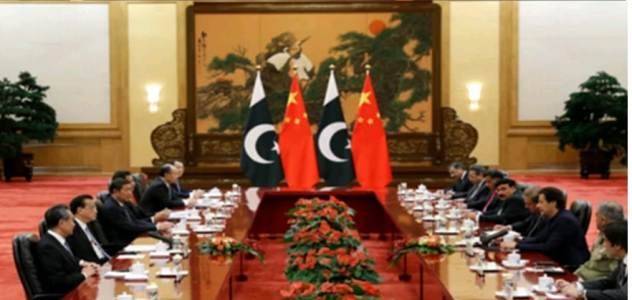CPEC turns out to be the largest investment project in geo economic growth
Shares

LAHORE - In terms of geo-economic growth, regional connectivity and development, China-Pakistan Economic Corridor (CPEC) has emerged extensively as the largest bilateral investment project as a boon for Pakistan, China and other regional countries in south Asia.
Pakistan and China are tied in multidimensional cordial relations on the basis of good friendship, mutual trust and understanding.
Though both countries, from time to time have been making policy adjustments in the light and need of global transformations, yet their mutual ties are continued to be in best coordination and harmony. World has witnessed that Pakistan and China are time tested friends and depend on each other deeply for the fulfillment of their strategic interests.
In Past, whenever Pakistan confronted any internal or external pressure or threat to its interests or security, China has immediately extended its full support to Pakistan by giving its air space, supporting its nuclear programme and protecting its economy from external threats or pressures.
China has significantly supported Pakistan on various international fronts like the United Nations Security Council (UNSC), the G-20 and the Nuclear Suppliers Group (NSG).The year 2015 is marked as the big boost in both countries’ relations reaching at climax as the initiative of China Pakistan Economic Corridor (CPEC) agreement worth $ 46 billion was announced.
The first phase of CPEC has successfully achieved its target on completing energy and road infrastructure development in Pakistan, while the second phase is to envision industrial cooperation, which has started bearing fruits and would further yield beneficial gains for the development of the economy of Pakistan.
CPEC project has brought forth many resources and opportunities for both the countries and has promoted their profits and interests respectively, but the mega project is viewed negatively by our neighbouring India and US, who are trying to sabotage it for promoting their agenda in South Asia. China, an emerging global super power, has the great potential and willingness to promote and support Pakistan, more than any other country or power in the world.
In the ongoing second phase of CPEC, according to the Pak-China Free Trade Agreement’s (FTA) segment-II, China would help open-up to 90 percent of its markets for Pakistani products and exports in a cooperation and effort to address trade imbalance between the two countries. On December 1, 2019, the Protocol to Amend the Free Trade Agreement between China and Pakistan entered into new shape and force, to make substantial revisions to the China-Pakistan Free Trade Agreement (CPFTA) which was first signed in November 2006.
According to the Amended Protocol document which is also known as CPFTA Phase-II, it would help deepen trade ties between Pakistan and China through increasing relaxation and liberalization of trade in goods, protecting and safeguarding mechanisms for domestic industry of Pakistan.
CPEC Project Director Dr. Liaqat Ali Shah told APP that the incumbent government of PTI was achieving immediate results from CPEC at a fast pace, adding that despite challenges on economic front and COVID-19 pandemic, immense unemployed youth were being provided internship opportunities, whereas the skilled professionals were already doing jobs under this project.
To a query Shah said that the work on the second phase of China-Pakistan Economic Corridor (CPEC) Phase-II was going on a fast pace, adding defeating the debunkers who had been trying to malign the incumbent authority on account of slow-down in CPEC activities; It was a great achievement, he added.
Giving the details of the projects under Phase two, he said that the groundbreaking of two mega hydel power projects worth $11 billion, materialising special economic zones, talks with the Chinese side on financial matters of $7.2 billion ML-1 railway project, speedy construction and development of the Gwadar port city, and expanding the scope of CPEC by including science, agro-technology and tourism sectors show the outcome that work on the game-changer project was in full swing.
The CPEC under its second phase was moving forward in a result oriented direction without any delay. The incumbent government was working swiftly according to the CPEC Authority Bill-2020 to facilitate the local and foreign investors, while ensuring smooth execution of industrial projects being carried out under phase two, he informed. Federation of Pakistan Chamber of Commerce and Industries (FPCCI) president Mian Nasser Hyatt Magoo told APP that in the second phase of CPEC, setting up of Special Economic Zones (SEZs) and developing the industrial sectors would bring industrial revolution in the country.
He lauded the incumbent Pakistan Tehreek-e-Insaf government for setting up mega industrial projects under the 2nd phase of CPEC. After becoming fully operational, the Gwadar port would become a harbinger of massive export-import activity and a new industry gateway to both the Central Asian and Persian Gulf countries, he added.
Magoo, while replying to a query said that the energy and goods transportation would engage the economic partnership of around 64 countries of Europe, Asia and the Middle East. CPEC was a tower of economic success and a hope of the people of the whole region, having the scope of an advanced future to strengthen a digital economy based upon peace and prosperity, he said.
Under phase two of the CPEC, the newly established Rashakai Special Economic Zone (SEZ), has started creating employment opportunities for the local youth of Khyber Pakhtunkhwa (KPK), which would further help contribute to the socio-economic development of all the provinces of the country, he asserted.
For example, he said, any item produced at Rashakai SEZ, which was being developed in a public-private partnership, would easily be exported to the neighbouring Afghanistan and Central Asian Republics (CARs), due to its proximity to Torkham (Pak-Afghan) Border.
